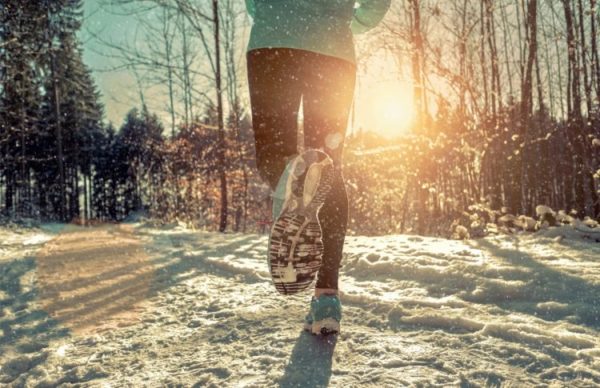“Slipping, sliding, icy-slushy slogging. Breathing through a mask, nose running, glasses fogging.”
This is the dismal jingle of runners in northern climates everywhere at this time of year. But for many, all of that is still preferable to the monotony of the treadmill or dizzying laps around tiny indoor running tracks.
For those who opt to run outdoors during the winter, we feel your pain, and we want to help. So, to keep you running safe, warm and happy all winter long, we have tips and gear recommendations from a couple of outdoor experts.
Risks of Running in Extreme Cold
Before you think about what to put on for your next cold run, take a moment to consider whether you should be heading outdoors at all. Sub-zero temperatures; heavy, wet snow and icy roads or trails can pose serious risks to your health and safety.
Hypothermia occurs when the body’s core temperature drops dangerously low. However, because running raises body temperature so much, the risk during a run is actually quite low.
Even when it’s ridiculously cold outside, you don’t need to worry about freezing your lungs or airway tissues.
The biggest danger comes after you stop (hence the warming blankets at marathon finish lines). Longer run durations, slower speeds (especially lots of walking) and running in wet, snowy conditions or freezing rain also increase the risk. But if you can keep dry and keep moving, you should be fine even at very low temperatures.
Frostbite, or the freezing of skin tissue, poses a bigger risk to runners. The greatest risk is to exposed areas, usually the nose and face (especially cheekbones and around the eyes), ears, chin and neck.
On longer runs, fingers and toes may also be at risk if layers are too thin or tight, or if sweat or other moisture freezes next to the skin. To help gauge the risk of frostbite, refer to this wind chill chart, published by the National Weather Service.
OK to Breathe Frigid Air?
You might be wondering whether extremely cold air can damage your lungs or airways. “The nice thing about the airway is that the membranes are very hardy and there are many mechanisms for the air to be warmed,” says Dr. Sachin Gupta, a pulmonologist with his own practice in San Francisco.
In other words, even when it’s ridiculously cold outside, you don’t need to worry about freezing your lungs or airway tissues.
Still, when it’s really cold, you may experience shortness of breath, coughing, wheezing or a tight chest — all symptoms of exercise-induced “bronchoconstriction,” formerly known as exercise-induced asthma.
But Gupta says not to worry too much about it. The worst effect is that it cuts your run short. Even recurrent episodes should not cause any sort of permanent impairment, Gupta says. He suggests wearing a scarf or mask over your nose and mouth, which helps pre-warm and moisturize the air to prevent these symptoms.
With smart pre-planning, however, you can avoid that kind of suffering during your run.
“Look at the weather coming up in the week ahead and plan your running workouts with that in mind,” says Sandy Gregorich, an instructor at Cornell University’s Outdoor Education program in Ithaca, N.Y. “Choose the worst cold and icy day and cross-train on that one, or make it your day off. Choose the best weather day to do your tempo or long run. And don’t be inflexible about rearranging things.”
Protect Yourself From Head to Toe
If you do opt to run in the cold, here’s a gear guide to help keep you dry, warm and safe:
Headwear: You know that old saying that you lose half your body heat through your head? It turns out that’s only true if you don’t cover it up, according to a 2006 study published in the Journal of Applied Physiology.
As with other body parts, match this gear to the conditions, wearing ear muffs or a thermal headband in mildly cold temps. Swap that out for a hat when it’s really cold, and pull on a hood when the temperatures get extreme.
Eye protection: Sun glaring off ice and snow can be more dangerous to your eyes than a bright summer day, so it’s a good idea to always wear a pair of sunglasses.
 Credit: Weston Ski Track/Paddle Boston
Credit: Weston Ski Track/Paddle BostonAccording to Jonathan Moore, a naturalist guide at Weston Ski Track/Paddle Boston in Weston, Mass., polarized sunglasses don’t cut through that ice glare as well as regular sunglasses. Moore recommends bringing along a pair of each.
One of the biggest irritants of outdoor exercise in winter is the fogging of eyewear, especially when wearing a face mask or scarf. (When you breathe into a scarf covering your nose and mouth, it fogs up your glasses.) While there’s nothing guaranteed to work for everyone, there are some products that might help.
Anti-fog lens wipes and sprays can provide a short-term solution. But the most common fix suggested by the runners surveyed for this article: wear contacts, if you have them.
Face and neck protection: Protect the areas most vulnerable to frostbite, while cutting down on eyeglass fogging, by wearing a contoured mask that follows the lines of your face.
Choose a mask with breathable mesh over the mouth to prevent condensation, which can freeze. Another option is to try a combination sun/wind/frostbite skin balm. According to Moore, this “adds another layer, and can eliminate the need for a scarf or mask when the wind chill isn’t so extreme.”
Body: The two key words here are “layer” and “wicking.” Wicking fabrics, including wool, nylon, polyester/fleece, polypropylene and even bamboo, take your sweat and move it away from skin to the outside of the garment so you stay dry and your body temperature stays stable.
Sun glaring off of ice and snow can be more dangerous to your eyes than a bright summer day.
The fit of wicking garments should be close to the skin; not baggy, but not tight. Choose a fabric weight based on personal factors, like how much you sweat and whether you typically feel too warm or too cold when you run. Also, of course, base this selection on the day’s weather conditions.
Remember that getting too hot poses a bigger risk than feeling cold. Excess sweat can lead to dehydration, electrolyte imbalance and, ultimately, a greater hypothermia risk. So, layer your clothes and shed those layers as needed.
Hands and Feet: Sweaty feet can freeze fast, so be sure your socks are made of a wicking fabric, too. If you’ll be running through fresh snow, use a pair of gaiters. Those are nylon shoe covers you can pull on and attach to your laces, keeping snow from getting in around the ankles.
On your hands, employ the layering technique. Start with thin, wicking gloves, and in colder temperatures, pull a pair of roomy mittens over them.
Hydration: When it’s cold out, you may not want to drink as much water, but you must! Dehydration is just as big a risk when you’re running outside in the winter as in warmer months, sometimes even more so because of the dry air.
If you carry water when you run, keep in mind that when temperatures are very cold, your water can freeze. Prevent this by carrying an insulated water bottle or hydration pack and tube. Or, as Moore suggests, tape a hand warmer to your water bottle.
Traction: There are a few options to help you navigate the many different and dangerous surfaces winter can throw at you. If you’re running in a more urban setting, on icy sidewalks or paved trails, a pair of over-the-shoe ice cleats are a must.
According to Gregorich, the exact type and brand that works best will vary by person. She’s found that for lighter, shorter people, a more minimalist “tack-like” cleat works best. But for bigger runners, more substantial cleats may be necessary.
When snow is more than a few inches deep, Gregorich straps on a pair of running snowshoes. Smaller and lighter than hiking snowshoes, these are perfect for navigating trails — paved or otherwise — with several inches of snow pack or loose powder. The crampons (cleats that you strap to your shoes or boots) on these snowshoes can also help bite into hard-packed snow for better traction, especially over hilly terrain.
Next Avenue brings you stories that are inspiring and change lives. We know that because we hear it from our readers every single day. One reader says,
“Every time I read a post, I feel like I’m able to take a single, clear lesson away from it, which is why I think it’s so great.”
Your generous donation will help us continue to bring you the information you care about. What story will you help make possible?
© Next Avenue – 2020. All rights reserved.
Sponsored
Topics





